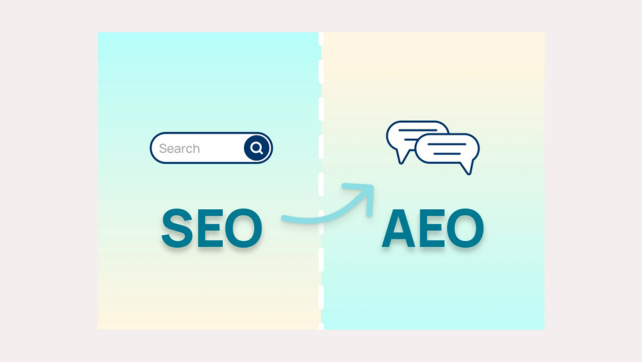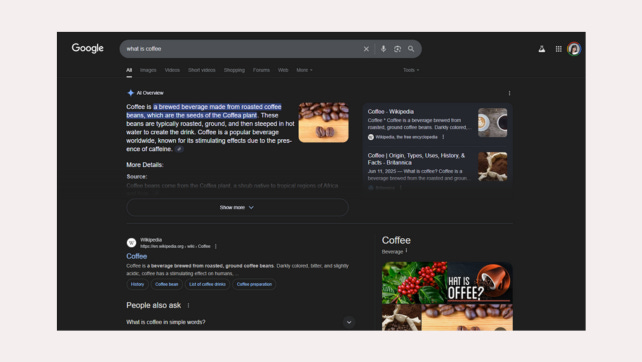How the rise of Answer Engines is changing SEO Forever
Google's shift to an "answer engine" is changing the fundamentals of SEO. Learn the new rules of Answer Engine Optimization (AEO) to maintain visibility and succeed as search evolves.
A personal discovery in the new era of search
Something interesting has been happening with my recent blog posts. While analyzing my traffic sources, I noticed new visitors arriving from unexpected places, not just traditional Google searches or social media links, but directly from AI tools like Perplexity and as cited sources in ChatGPT's answers.
It was a clear signal: the way people find and consume information online is undergoing a fundamental change. The game isn't just about ranking on a list of blue links anymore. We are now in the era of the "answer engine."
What was once a digital library that pointed you to different books (websites) is now becoming a sophisticated concierge that reads the books for you and gives you a direct, synthesized summary. This fundamental shift, driven by advancements in artificial intelligence (AI) like AI Overviews, is challenging established marketing strategies and redefining online visibility.
This shift presents both a huge challenge and a massive opportunity. In this article, I'll break down what Google's evolution means for us as marketers and creators. More importantly, I'll provide a practical playbook for not just surviving, but thriving in this new AI-first world.
The Marketing earthquake caused by the Answer Engine Model
Google's transition has created a seismic shift, altering how traffic is generated and how success is measured.
The decline of traditional clicks and the rise of "zero-click searches": By delivering summarized answers directly on the Search Engine Results Page (SERP), AI features significantly reduce the need for users to click through to websites. Studies predict a substantial drop in organic traffic, with some estimates as high as 25% by 2026. A majority of Google searches now result in no clicks, as users find their answers within features like AI Overviews, Featured Snippets, and "People Also Ask" boxes.
However, this isn't a simple story of traffic loss. Google indicates that the clicks that do come from AI-enhanced results are of "higher quality." This traffic tends to have longer session durations, lower bounce rates, and significantly higher conversion rates. This suggests a crucial shift: while traffic volume may decrease, the value of each remaining click increases because users arrive with more context and stronger intent.
The new goal from ranking to being cited: In the age of answer engines, the objective is no longer just to rank on page one. It's to become the definitive source that AI systems consult and cite. Having your content featured in an AI-generated answer is the new "Page 1."
A brand's authority, factual accuracy, and positive public sentiment directly influence whether AI deems it worthy of mention. AI models rely on Google's Knowledge Graph, which incorporates real-world signals like reviews, press mentions, and third-party citations. This means cultivating a strong, positive online footprint is now a direct SEO strategy. A "first-mover advantage" is emerging, where early citations in AI summaries create a self-reinforcing loop of trust and visibility.
Your new playbook for Answer Engine Optimization (AEO)
To thrive in this new world, marketers must adapt their content and SEO efforts. This new approach is called Answer Engine Optimization (AEO).
Crafting content for the Answer Engine: AEO is about optimizing content to be the direct, authoritative answer chosen by AI.
Answer first, context later: Structure your content to provide a clear and concise answer to a question at the very beginning, then elaborate on the details further down the page.
Use conversational language: Write as if you are directly addressing a person's question. Focus on question-based keywords and long-tail queries that resemble natural speech. This is crucial for both AI Overviews and voice search.
Balance brevity with depth: While AI favors concise answers for snippets, the underlying content still needs depth to establish authority. Provide quick answers "above the fold," but support them with comprehensive, well-researched content.
Structuring content for AI understanding: Meticulous structure helps AI understand your information.
Structured data (Schema Markup): This is essential. Implementing relevant schema (e.g.,
FAQPage,HowTo,Product) acts as a direct "language" for your website to communicate with AI models.Clear hierarchy: Use heading tags (H1, H2, H3) logically, ideally phrasing them as direct questions that your content answers.
Readability formats: Use bullet points, numbered lists, tables, and short paragraphs to make content easy for both humans and AI to scan.
Building trust with E-E-A-T: Google's AI prioritizes content from authoritative sources, making strong E-E-A-T (Experience, Expertise, Authoritativeness, Trustworthiness) signals fundamental. To be cited by AI, your content must demonstrate genuine human expertise, originality, and factual accuracy supported by credible sources. Regular updates are crucial to signal that your information is current and reliable.
Optimizing for a multimedia world: Modern AI can process multimodal data (text, images, video, and audio). Traditional text-based SEO is insufficient.
Images: Optimize images with descriptive alt text, file names, and captions.
Videos: Provide full transcripts and use timestamps to help algorithms understand the content breakdown.
Page experience: Core Web Vitals (loading speed, interactivity) and mobile-first design are paramount, as they directly impact how easily AI crawlers can access and index your content.
Diversifying for multiple AI ecosystems: The search landscape is fragmenting. It's wise to optimize your content not just for Google but for other emerging AI answer engines like Microsoft Bing AI (Copilot), ChatGPT, and Perplexity AI. While the core principles of quality and structure apply, each has nuances. For example, ChatGPT favors sites known for stable, authoritative content and brand mentions across the web, not just classic SEO signals.
Adapting business models for the AI era
Google's evolution necessitates a reevaluation of monetization and advertising strategies.
Rethinking advertising and commercial intent: When users get answers directly from AI Overviews, traditional ad impressions and clicks can drop. This shifts the value towards queries with clear commercial or transactional intent (e.g., searches for service features, pricing, or product comparisons). Advertisers must refine their targeting and ad creative for these high-intent searches. Google is also testing new ad formats within its AI results, making the synergy between paid and organic strategies more critical than ever.
Leveraging AI tools for quality and efficiency: AI tools enable rapid content production, but this also increases competition. Google's stance is clear: quality is what matters, not how the content was produced. Low-quality, AI-generated content will be penalized. The key is to view AI as an "enabler of quality." Use AI as a powerful assistant for research, drafting outlines, and optimizing content, but ensure that human experts provide the final strategic oversight, unique insights, and factual accuracy.
Navigating broader industry and regulatory challenges: Google's market dominance has attracted significant antitrust scrutiny. Regulators are concerned that AI Overviews threaten competition and unfairly appropriate content from publishers without compensation. The outcomes of these legal battles could reshape the economics of content creation, possibly necessitating new licensing models. This underscores the importance for businesses to build their own brand authority and direct audience relationships rather than being solely dependent on any single platform.
Conclusion
Google's transformation into a comprehensive answer engine is an irreversible and accelerating shift. The new battleground for online visibility is being cited as a trusted authority by AI systems. This requires a strategic pivot to Answer Engine Optimization (AEO), focusing on meticulously crafted, direct, conversational, and highly structured content backed by strong E-E-A-T signals.
While this transformation presents challenges, particularly for traditional organic traffic models, it also unlocks opportunities. AI-driven traffic, though potentially lower in volume, is often more qualified and can lead to higher conversion rates. Businesses that proactively embrace these changes, strategically leverage AI to enhance quality, and consistently prioritize user value will thrive.
To remain relevant, marketers must audit their content, invest strategically in AEO, and continuously adapt their digital strategies. The future of marketing belongs to those who understand that in this new era, being the answer is the new ranking.




